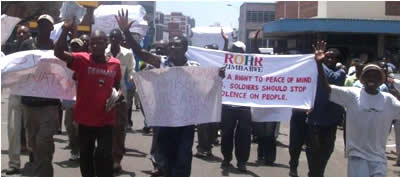Zimbabweans get up
As the SADC troika jetted into Harare yesterday to try (unsuccessfully) to make some headway in the stalled talks, a variety of different Zimbabwean civil society organisations gathered to protest the delays and demand a resolution of the country’s political crisis.
Read about some of these actions here:
- Riot police descend on women protesters – Women’s Coalition
- Police ruthlessly crush protest by youth activists – Youth Forum
- 23 injured, 7 arrested and 4 abducted after a ROHR demonstration – Restoration of Human Rights Zimbabwe
- Image Gallery – Restoration of Human Rights Zimbabwe demonstration
Zimbabweans are speaking out. It’s time SADC also took a stand on these stalemated negotiations.



Tuesday, October 28th 2008 at 1:17 pm
Hello, Amanda.
Can you tell me if there is food in Zimbabwe?
Are the stores opened or closed?
How is the situation of people?
Thank you.
I am waiting forward for your answer.
Elizabeth Beloqui.
Tuesday, October 28th 2008 at 3:09 pm
Let me play Devil’s advocate. Can we believe these numbers?
The Women’s Coalition says they “had mobilized nearly 1000 women who were tear-gassed and badly beaten”.
The Zimbabwe Youth Forum says: “Thousands of youth gathered around the Harare International Conference Centre”
Restoration of Human Rights (ROHR) says “More than 200 ROHR activists participated in demonstrations that brought business to a standstill.”
Bu the AFP says: “47 people were arrested and eight injured on Monday when police violently broke up a protest by 100 activists who tried to march by the summit.”
How many people were really there? Were there several thousand or just a hundred? I’m inclined to believe that the NGOs are inflating their numbers. Also, the indications seem to be that these different groups were there at different times? Why weren’t they co-ordinated to be there together? Why weren’t other organizations who are renowned for demonstrating also there? Was WOZA there or not? Where was the NCA? And ZINASU? And CHRA?
Is there any reason why these NGOs can’t muster a real “thousands of people” to demonstrate at an occasion like this? These protests are all about numbers. Once the numbers are big enough, the police will back down. It’s been seen in Eastern Europe; there’s no reason it can’t happen here. Small numbers of demonstrators are doomed, and will only suffer the fate of Jenni Williams and Magodonga Mahlangu, brave though they are.
If the SADC meeting should take place here, let’s see all the NGOs out on the streets. Even the public will join in then.
Wednesday, October 29th 2008 at 9:07 am
Roger, isn’t it important that people are standing up and marching for change? So what if there were just a hundred? Those are a hundred very courageous people who had the guts to do something about the problems we all face. Where were you?
Wednesday, October 29th 2008 at 10:05 am
I think Roger raises a couple of important points.
I see the recent protests as symbolic rather than strategic. There’s nothing wrong with that but it would be more useful if civic organisations collaborated and reached out to their constituents (you and me) and coordinated a large protest. Larger protests are much harder for the regime to deal with whilst the smaller ones are more easily neutralised. Roger is correct in saying that protests are about numbers.
Also, members of the public often need to be persuaded, encouraged and led into protests. They don’t just wake up one morning and decide to put on their protest boots and go down town. So civic organisations have to do a better job at encouraging the general public to join them on the streets.
I haven’t been checking my email all that well lately but who out there got an SMS, or an email, or a flier, a fax, or received a telephone call from any of the groups mentioned in Amanda’s blog inviting them to be a part of the march and giving times/venues etc?
If the public wanted to get involved in these protests how do they break into the inner circle of knowledge about logistics?
Civil society faces the same challenges as the MDC does; a crisis of confidence in whether their calls for participation in street protests will be taken up. Thus we see the same pool of activists protesting without any growth, without any broader participation from other people.
Let’s see WOZA, the NCA, CHRA, the Women’s Coalition, the MDC and the students collaborate on coordinating a united peace march. And let’s see these organisations reach out further than their head offices and their inner circle of faithfuls.